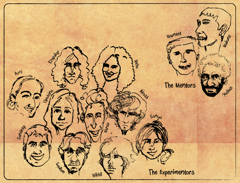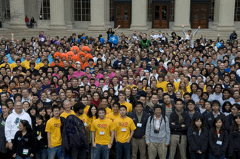Art of Synthetic Biology
Air Date: Week of November 20, 2009

The members of ArtScience Bangalore. (Courtesy of ArtScience Bangalore)
The tools necessary to create new forms of life are moving from the labs of scientists to the studios of artists. One group of design students got their hands wet in the world of synthetic biology by trying to create a bacteria that smells like the first rain of a monsoon. Living on Earth’s Ike Sriskandarajah reports.
Transcript
YOUNG: It’s Living on Earth, I’m Jeff Young. College and high school students from around the world traveled to MIT for an unusual event called IGEM – the International Genetically Engineered Machines Competition. The students build novel forms of life from biological parts. The field of synthetic biology is expanding, and so is the sphere of those who use it. Living on Earth’s Ike Sriskandarajah found out what a team of artists brought to the science competition.
[VOICES TALKING IN CROWDED ROOM]
SRISKANDARAJAH: At first glance, IGEM looks like summer camp. Kids in matching team shirts swarm around talking about their projects – except the arts and crafts here are new life forms.
THATTAI: It’s true, there’s some cool science going on.
SRISKANDARAJAH: Mukund Thattai, an IGEM veteran, who runs a leading synthetic biology lab in Bangalore points out a team that made bacteria that grow bright yellow when they touch land mines. Then there’s the team with bacteria that find and seal microscopic leaks in water pipes.
THATTAI: If you told somebody up front that undergrads would be working on this, they’d come up with their own ideas. Not that it’s going to work, even if they were attempting it, they would laugh at you. If you were more experienced you wouldn’t try this. There’s no lack of ambition, isn’t not that…what is that word?
SETHI: Gumption.
THATTAI: Gumption. Exactly. Exactly.
SRISKANDARAJAH: Mukund advised the wildest team of all: Art Science Bangalore. Team member, Avni Sethi:
SETHI: As artists and designers, there is a certain gumption that comes into the picture. And that is sort of the basis of anything that we’d end up doing.
The rain plays an important cultural role in India. Most Bollywood films feature at least one "wet" scene.
SRISKANDARAJAH: So, teammate Upanasa Simha says they felt like they could do anything.
SETHI: We don’t know anything technical. We don’t know whether anything is possible but that fact that that’s not restricting us in any which way it’s so…we’ve got a crazy imagination for bacteria and so we imagined all of it, and then drew it with paint and paper.
SRISKANDARAJAH: They dreamt and drew strange microbial creatures like lie-detecting bacteria – bugs that would destroy materialism.
SETHI: And one of the things that we drew was something called “action dopamine”, which was this bacteria that would sense love. And as it would sense love, it would start smelling of rain. So, that was the initial idea.
SRISKANDARAJAH: But their imagination hit a scientific roadblock.
SETHI: If we were to do something like that we’d have to work with neurotransmitters, and in this case dopamine, and that would have been extremely complex.
SRISKANDARAJAH: So, they simply bypassed it.
SETHI: And then we sort of focused on the smell of rain.

Over 110 teams from around the globe attended the iGEM Jamboree. (Photo iGEM and David Appleyard.)
SRISKANDARAJAH: Specifically, the first monsoon rain.
SETHI: Especially in the Indian context. Rain plays such, such an important part. Meaning, from the monsoons to Bollywood romance, all of it is somewhere embedded in the rains.
[STRAINS OF BOLLYWOOD SONG BEGINNING]
SRISKANDARAJAH: Like this song from the 1994 classic “Mohra.” The raining water kindled a fire.
[WOMAN SINGING HINDI “TIP TIP BARSA PAANI”]
SRISKANDARAJAH: What is the first rain, like if you had to use words to describe it?
[SOUNDS OF CROWDED ROOM; VOICES CHATTERING]
SETHI: Fresh. Extremely sensual. Meaning, that I can go on to saying to the extent of erotic. First rain, especially.
SRISKANDARAJAH: Which is the steamiest description of a science project I’ve ever heard.
[BOLLYWOOD MUSIC CLIMAX]
SRISKANDARAJAH: They had the passion and the imagination, but to flesh out the poetry they needed science.
SETHI: It started off with just looking up the internet saying, okay what is cell, what is gene, what is DNA? Right from there we went through eleventh standard biology definitions of all of these things. And then slowly in the lab was, how do you see a DNA? So, step-by-step, it got a little more complicated. So, we took this little bit – I feel love, it smells of rain – to the lab and then the lab said, well, a lot of this seems possible, but let’s work backwards.

The members of ArtScience Bangalore. (Courtesy of ArtScience Bangalore)
SRISKANDARAJAH: So, working backwards from the smell of rain to its chemical source.
SETHI: Geosmin. Which is a metabolite that is responsible for the smell.
SRISKANDARAJAH: Geosmin means literally “smell of the earth”. It’s created by algae that live in the dirt. The team ID’d the genetic instructions that make Geosmin and plugged them into the common, lab-friendly bacterium, E. coli.
SIMHA: So, now when we insert this into our E. coli it should essentially produce Geosmin.
SRISKANDARAJAH: And it did!
SETHI: The moment we opened that little test tube. I was like, “Mmm, rain!” [Giggles]
SIMHA: And it came back all as, “We’ve do it! It smells of rain and everything.”
SRISKANDARAJAH: Though, it wasn’t as evocative as they’d hoped.
SETHI: It was a little musty, but it was certainly wet. Yeah. But, apparently, that’s how E. coli kind of smells. So, maybe it smells like E. coli and something else. [Laughs]
SRISKANDARAJAH: But the damp bug smell isn’t all that art-science achieved. On the last day of the competition the judge announced the winning teams.
JUDGE: In determining the award for best presentation, what we felt was most important was how well you’re able to teach everyone through your presentation. So, for teaching us about extreme resourcefulness, wild creativity, and raw tenacity the award goes to Art-Science Bangalore!
[CHEERING CROWD AND APPLAUSE]
SIMHA: We were really surprised that we won.
SRISKANDARAJAH: The team also succeeded in washing away the old approach of synthetic biology.
SIMHA: The judge said that like the steam changed the way that one of the judges used synthetic biology. So, I was like, “wow, that’s really cool.”
SRISKANDARAJAH: The experience changed their point of view, as well. Dissolving the divisions between art and science. And, inspiring them for next year’s project!
SETHI: Well, when you’re walking down New York City every, every like 20 meters that you walk you smell a new smell.
SIMHA: Next IGEM, next IGEM we will like recreate the different smells in New York.
SRISKANDARAJAH: For Living on Earth, I’m Ike Sriskandarajah.
Links
Living on Earth wants to hear from you!
Living on Earth
62 Calef Highway, Suite 212
Lee, NH 03861
Telephone: 617-287-4121
E-mail: comments@loe.org
Newsletter [Click here]
Donate to Living on Earth!
Living on Earth is an independent media program and relies entirely on contributions from listeners and institutions supporting public service. Please donate now to preserve an independent environmental voice.
NewsletterLiving on Earth offers a weekly delivery of the show's rundown to your mailbox. Sign up for our newsletter today!
 Sailors For The Sea: Be the change you want to sea.
Sailors For The Sea: Be the change you want to sea.
 The Grantham Foundation for the Protection of the Environment: Committed to protecting and improving the health of the global environment.
The Grantham Foundation for the Protection of the Environment: Committed to protecting and improving the health of the global environment.
 Contribute to Living on Earth and receive, as our gift to you, an archival print of one of Mark Seth Lender's extraordinary wildlife photographs. Follow the link to see Mark's current collection of photographs.
Contribute to Living on Earth and receive, as our gift to you, an archival print of one of Mark Seth Lender's extraordinary wildlife photographs. Follow the link to see Mark's current collection of photographs.
 Buy a signed copy of Mark Seth Lender's book Smeagull the Seagull & support Living on Earth
Buy a signed copy of Mark Seth Lender's book Smeagull the Seagull & support Living on Earth

